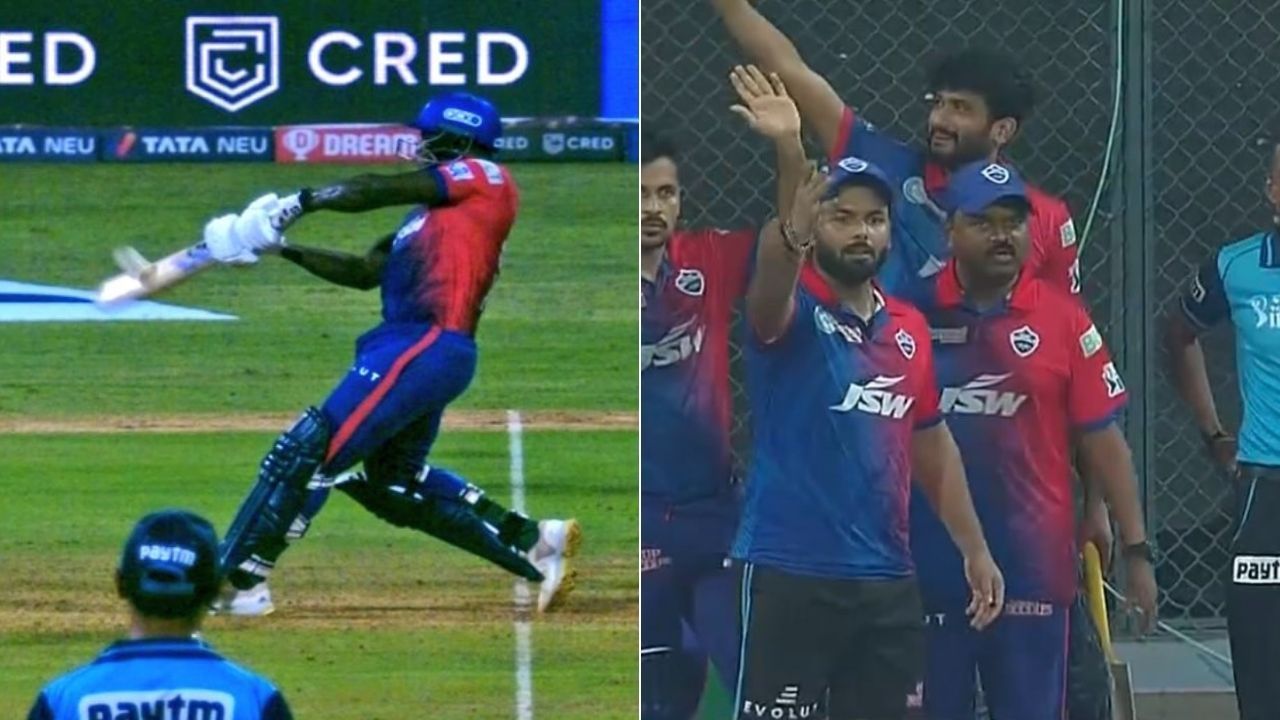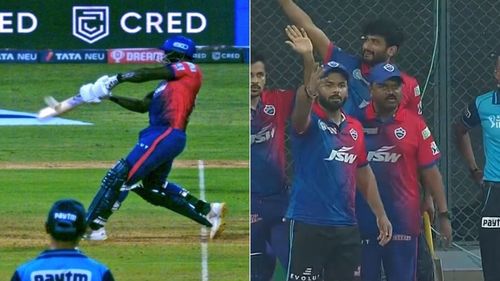
IPL umpiring gaffe opens up another can of worms

22nd April 2022, a tightly-contested Indian Premier League (IPL) fixture between the Delhi Capitals and the Rajasthan Royals sits on a knife-edge. The Capitals need 36 off the final over of their run-chase, but when Rovman Powell lays into Obed McCoy’s opening two deliveries, the impossible seems within grasp.
McCoy, as you would have guessed by now, has started feeling the pinch. Before the over began, it was assumed that only something dramatic would take this IPL game away from RR. Two balls in, it seems that something dramatic is on the cards. And then, under the weight of expectations, he cracks.
The pacer bowls a rib-high full toss that is absolutely met by Powell. The ball goes soaring over the deep mid-wicket fence and sends thousands of DC supporters into delirium. The batters and the dug-out, though, are more interested in the fairness of the delivery. If it were to be deemed a no ball, they would get a free hit, with the equation also being reduced to 17 runs off 4 balls – a perfectly manageable task in the IPL.
Massive controversy erupted in the IPL on Friday
But the umpires (Nikhil Patwardhan and Nitin Menon), for once, remain steadfast. They show character and conviction in their decision-making and decide not to bother the third umpire, who they often revert to for the most minor of inconveniences. The only problem is that they get it horribly wrong. It is as compelling a case of incompetence as any in the IPL, which unsurprisingly, gets highlighted on social media.
Umpiring in the IPL, however, is a tough gig. There is a human element attached to it, after all. Deciding whether a delivery qualifies as a waist-high no ball is tough in slow motion and these guys had to arrive at that conclusion in a split second. They messed it up, quite royally too. The bigger discussion, though, is whether this entire thing could have been avoided – either by more umpiring vigilance or by making the IPL rules & regulations slightly less grey.
There is a school of thought that the umpires should have checked upstairs, considering the on-field umpires spend most of their time chatting with the third umpire during the IPL. That, however, might not have been what the rules mandate – again, something that defies common sense but is something that is etched in the playing conditions.
Section 2 of Appendix D of the IPL 2022 playing conditions, which revolves around Umpire Review, tackles everything except what the umpires should be doing when there is a waist-high no ball and the batter is not dismissed. There are provisions to check (often re-check till the crowd gets bored) if a dismissal occurs. But if someone like Powell hits a six, the batting side isn’t really being given the advantage of the bowling team’s error.
Section 2 states, “In the circumstances detailed in paragraphs 2.1, 2.2, 2.3 and 2.4 below, the on-field umpire shall have the discretion to refer the decision to the third umpire or, in the case of paragraphs 2.2, and 2.4, to consult with the third umpire before making the decision.”
Sub-section 2.1 refers to Run Out, Stumped, Bowled and Hit Wicket decisions. 2.2 talks about Caught decisions and Obstructing the Field, 2.3 denotes Boundary Decisions, and 2.4 deals with Batters Running to the Same End.
There is a sub-section 2.5 too, which finally talks about no balls. Here, though, there is a mention of clause 21.5. 2.5.1 mandates, “For each delivery during the match, the third umpire shall check in real time the fairness of the delivery as per the provisions of clause 21.5.” 2.5.2 says that if the third umpire determines the delivery was not a fair one, he/she will communicate this via two-way radio to the bowler’s end umpire who shall then call and signal no ball.
But here’s the catch. Clause 21.5 only talks about front-foot and back-foot no balls – no balls that the third umpire is anyway checking each time a ball is bowled. Funnily enough, section 21, which talks about what constitutes a no ball, speaks of every other transgression apart from a waist-high full toss being deemed unfair.
The waist-high no ball is only talked about in Section 41.7.1 under the ‘Unfair play’ heading. Section 41.7.1 states, “Any delivery, which passes or would have passed, without pitching, above waist height of the striker standing upright at the popping crease, is to be deemed to be unfair, whether or not it is likely to inflict physical injury on the striker. If the bowler bowls such a delivery the umpire shall immediately call and signal no ball.”
This, by the way, constitutes waist height, “For the purposes of these Playing Conditions, waist height is defined as the point at which the top of the batter’s trousers would conventionally be when he is standing upright at the popping crease.” With so much technology around, it seems quite odd that cricket is still relying on convention and where players wear their trousers to make black-and-white calls.
Hence, it might help the umpires and the IPL if the definition of a waist-high no ball is included in the part where other types of no balls are defined, and if they are defined somewhat objectively. The other perplexing aspect is that umpires in the IPL are simply not allowed to discuss with the third umpire whether there was a waist-high no ball. The only time they can do so is after a dismissal.
So, imagine this. India and Virat Kohli need 8 runs off 2 balls in the final of the T20 World Cup against Pakistan. Rohit Sharma is at the other end too. Shaheen Shah Afridi bowls a chest-high full toss that the on-field umpires deem fair. Kohli misses this ball altogether and it bobbles through to Mohammad Rizwan.
Unsurprisingly, Kohli and Rohit remonstrate but hey, the rule says the umpires can’t go upstairs. Almost in disdain, Kohli smacks the next ball for six and India lose the T20 World Cup by 1 run. Still can’t fathom the uproar it’ll lead to, right?
This situation can very easily be avoided. It took a manic and heart-breaking 2019 ICC Cricket World Cup final for the ICC to realise that some of its rules were, simply put, quite farcical. In an ideal world, it shouldn’t take such instances for them to understand how many grey areas there exist.
One thing that the ICC can brood over is having the third umpire monitor all waist-high no balls too. For that to happen, though, they will first have to include waist-high no balls under the no ball definition and ensure it falls within the ambit of Clause 21.5 because that is one thing Section 2 (Umpire Review) seems adamant on.
Long story short. The umpires should have called the no ball when McCoy speared the ball at Powell. But once Nikhil Patwardhan (the square leg umpire) hadn’t, due to his negligence or just because he was too stubborn to admit his mistake, there was nothing in the playing conditions that allowed them to have a second look. No ‘rocking n rolling’, no ‘can I have spin vision please’, no ‘there is clear gap between bat and ball but I still want to confirm with Ultra Edge’. Just a solitary gaze at it and the ultimate conclusion that it was a fair delivery.
The counter argument could be that by introducing reviews for wide/no balls in the IPL, too much time will be consumed. But those who’ve not lived under a rock for the past couple of years and have watched umpires waste time on the most trivial of details in the IPL, this argument is pretty average.
Rishabh Pant and the Capitals embarrassed themselves by reacting the way they did, make no mistake about it. Irrespective of whatever ‘heat of the moment’ they were going through, they should never have sent their coach or anyone from their contingent to argue a contentious decision, especially in a top competition such as the IPL. They have rightly been reprimanded and reminded that these things can never happen, no matter what.
This article, though, isn’t about what wrong the Capitals did, the mistakes the umpires committed, or the uproar on social media. Instead, it is about how we might have been oblivious (in the IPL and otherwise) to such glaring loopholes in the current IPL (and ICC) playing conditions – playing conditions that, lest we forget, is what all cricketers and umpires must eventually abide by.
And at the moment, it just doesn’t seem good enough. Or more tellingly, clear enough.